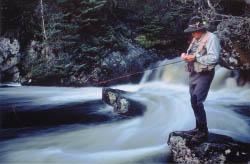Editorial

By Chris Marshall
Many of us are enticed and captivated by fly fishing through
the richness of its traditions. There is a singular delight
in reproducing classic flies developed generations ago,
stroking the patina of a hand-crafted bamboo rod, or curling
a line over the pools of legendary rivers. However; we're
equally drawn by the opposite - by the challenges imposed by
changes in conditions, new species, and geographical relocation.
The history of fly fishing in Canada is filled with this.
The first fly fishers in this country used traditional British
gear, flies and techniques. These were gradually adapted to suit
the different conditions of the New World, such as the development
of salmon flies constructed from the easily obtainable hair of
local animals rather than the exotic feathers of their traditional
antecedents. Gradually, these and similar innovations became
established as traditions of their own and, in turn, were adapted
to meet new situations elsewhere. The application of West Coast
steelhead flies is a prime example.
The point is that, however much we might delight in ambiance of the
traditions of fly fishing, there is even greater delight when we
innovate and adapt those traditions in the face of challenge. In
every corner of this vast country there are fly fishers pushing
at the boundaries of streamcraft, technique, and the design of
equipment and fly pattersn. And it is a regional phenomenon:
innovation is initiated by individuals or small groups to meet
challenges arising from local conditions.
Vic Bergman's companion features in this issue [Summer 2002] on
pike fishing in Alberta and on pike fly patterns are excellent
examples of this. In a province where trout fishing is paramount,
Vic extends fly fishing to a species more usually pursued east of
the Alberta border. Indeed, he borrows heavily from traditions
developed in Ontario and Quebec. However, he does more than
borrow: he adapts. And there is much that fly fishers in Ontario,
in Quebec and in regions wherever pike swim can learn from his
adaptions. It's a process of constant reciprocation, cross-fertilization
and hybridization - a process in which we are able to toss ideas and
innovation back and forth from region to region, constantly learning
from each other.

This process lies at the heart of the editiorial mandate of The
Canadian Fly Fisher. While there will always be a few whose
vision is cramped by the boundaries of their local waters, most
of us embrace the larger vision. We welcome the opportunity to
reach out and share the experience of those who delve in waters
beyond our immediate horizons.
It is this vision which prompted us to feature a garpike of the
cover of this issue, even though readers outside Ontario and Quebec
have little opportunity to fish for them. For the same reasons,
we featured West Coast salt waster in the photo essay of the
Spring 2002 issue and plan to feature Kamloops in "The Downtown
Fly Fisher" in the Fall 2002 issue.
And even if we might not find there anything which is obviously
applicable to our local situations, we can always take vicarious
pleasure in fishing distant waters which we might never have the
opportunity to visit in person, and for species which we might
never see except in our imaginations. ~ Chris Marshall
|



